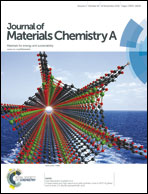Mechanistic studies on lithium intercalation in a lithium-rich layered material using Li2RuO3 epitaxial film electrodes and in situ surface X-ray analysis†
Abstract
The surface structure of a lithium-rich layered material and its relation to intercalation properties were investigated by synchrotron X-ray surface structural analyses using Li2RuO3 epitaxial-film model electrodes with different lattice planes of (010) and (001). Electrochemical charge–discharge measurements confirmed reversible lithium intercalation activity through both planes, corresponding to three-dimensional lithium diffusion within the Li2RuO3. The (001) plane exhibited higher discharge capacities compared to the (010) plane under high rate operation (over 5 C). Direct observations of surface structural changes by in situ surface X-ray diffraction (XRD) and surface X-ray absorption near edge structure (XANES) established that an irreversible phase change occurs at the (010) surface during the first (de)intercalation process, whereas reversible structural changes take place at the (001) surface. These experimental findings suggest that the surface reconstructed phase limits lithium intercalation between the electrode and the electrolyte, leading to the poor rate capability of the (010) film. Surface structural changes at the initial cycling therefore have a pronounced effect on the power characteristics and stability of lithium-rich layered materials during battery operation.


 Please wait while we load your content...
Please wait while we load your content...